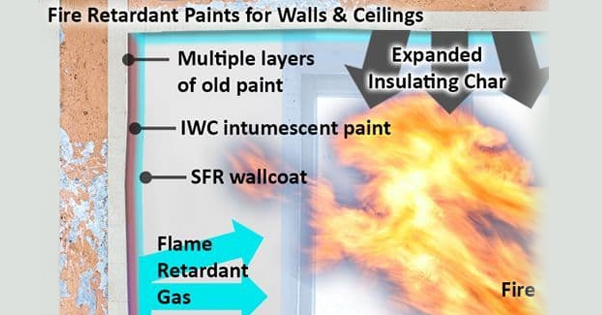The Protective Power of Fire Retardant Coatings: An In-Depth Exploration
Introduction:
Fire retardant coatings are specialized materials applied to surfaces in buildings, structures, and various materials to enhance their resistance to fire. Unlike traditional building materials that may ignite, burn, or lose integrity when exposed to high temperatures, fire retardant coatings are designed to slow down or prevent the spread of fire, providing critical protection to both the structure and its occupants. This article delves into the science behind fire retardant coatings, how they work, their types, applications, and their vital role in passive fire protection.
1. The Science Behind Fire Retardant Coatings:
Fire retardant coatings work by interrupting one or more of the processes that allow fire to sustain and spread. To understand how they offer protection, it's essential to grasp the fundamental elements of fire and how coatings interfere with these elements.
1.1. The Fire Triangle:
Fire requires three elements to sustain itself: heat, oxygen, and fuel. This concept is often represented by the "fire triangle":
- Heat: The energy necessary to raise the material's temperature to its ignition point.
- Oxygen: The gas that supports combustion.
- Fuel: The material that burns, providing the chemical energy for the fire.
Fire retardant coatings are designed to disrupt one or more sides of this triangle, thereby inhibiting the fire's ability to propagate.
1.2. Mechanisms of Action:
Fire retardant coatings employ several mechanisms to protect materials from fire:
- Thermal Insulation: Some coatings create a barrier that insulates the underlying material from heat, reducing the rate at which it heats up and potentially ignites.
- Chemical Reaction: Many fire retardant coatings undergo a chemical transformation when exposed to heat, such as intumescence, where the coating expands to form a thick, char-like insulating layer that protects the material beneath.
- Oxygen Deprivation: Certain coatings release gases that dilute the oxygen concentration around the fire, effectively smothering it or reducing its intensity.
- Cooling: Some fire retardants work by absorbing heat and releasing it in a less harmful form, such as water vapor, thereby lowering the temperature of the material and slowing combustion.
2. Types of Fire Retardant Coatings:
Fire retardant coatings come in several forms, each with specific properties and applications. The choice of coating depends on the material being protected, the level of fire resistance required, and the environmental conditions.
2.1. Intumescent Coatings:
How They Work:
Intumescent coatings are one of the most commonly used fire retardants, particularly in structural applications like steel beams and columns. When exposed to high temperatures, these coatings undergo a chemical reaction that causes them to expand significantly. This expansion forms a thick, foam-like layer that insulates the material beneath from the heat of the fire.
Applications:
- Structural steel in buildings and infrastructure.
- Timber and wood-based products.
- Fire doors and partitions.
Benefits:
- Provides thermal insulation and protects structural integrity.
- Lightweight and can be applied as a thin layer.
- Often used in environments where aesthetic appearance is important, as they can be finished to look like ordinary paint.
2.2. Ablative Coatings:
How They Work:
Ablative coatings protect by absorbing heat and gradually degrading through a process of controlled burning or charring. As the coating degrades, it absorbs energy, which prevents the underlying material from reaching its ignition temperature.
Applications:
- Fire-resistant cables and wiring.
- Structural components exposed to intense heat.
- Industrial and marine environments where extreme temperatures are encountered.
Benefits:
- Effective in high-temperature environments.
- Helps maintain the integrity of cables and critical components during a fire.
2.3. Cementitious Coatings:
How They Work:
Cementitious coatings are thick, plaster-like materials that provide passive fire protection by acting as a thermal barrier. These coatings are composed of lightweight cement-based materials that adhere to surfaces, providing substantial fire resistance.
Applications:
- Structural steel and concrete in buildings.
- Large industrial facilities where fire resistance is crucial.
- Offshore platforms and refineries.
Benefits:
- Highly durable and resistant to weathering.
- Provides robust fire protection for structural elements.
- Suitable for applications where a high level of fire resistance is required, such as in industrial and commercial buildings.
2.4. Fire Retardant Paints:
How They Work:
Fire retardant paints are similar to standard paints but contain special additives that provide fire resistance. These paints do not significantly alter the appearance of the substrate but offer enhanced protection against fire.
Applications:
- Interior and exterior walls.
- Wooden surfaces.
- Decorative elements that require fire protection without compromising aesthetics.
Benefits:
- Easy to apply using standard painting methods.
- Can be used in residential and commercial settings.
- Provides an additional layer of protection without altering the appearance of the substrate.
3. Applications of Fire Retardant Coatings:
Fire retardant coatings are used in a wide range of industries and applications, providing essential protection for buildings, infrastructure, and critical assets.
3.1. Structural Protection in Buildings:
One of the most common applications of fire retardant coatings is in the protection of structural elements within buildings, particularly steel beams and columns. Steel is widely used in construction due to its strength and flexibility, but it is vulnerable to weakening at high temperatures. Fire retardant coatings, particularly intumescent coatings, are applied to steel structures to prevent them from reaching temperatures where they would lose their load-bearing capacity.
Example:
In high-rise buildings, where evacuation can take longer, fire retardant coatings on structural steel ensure that the building remains stable during a fire, providing critical time for occupants to escape and for emergency responders to act.
3.2. Protection of Wood and Timber Products:
Wood is a combustible material, making it particularly susceptible to fire. Fire retardant coatings can significantly improve the fire resistance of wooden structures, making them safer in the event of a fire. These coatings are commonly used in residential and commercial buildings where wood is used for structural or decorative purposes.
Example:
In heritage buildings, where preserving the original wooden structures is important, fire retardant coatings can provide the necessary fire protection without altering the appearance of the wood.
3.3. Industrial and Commercial Applications:
In industrial and commercial settings, fire retardant coatings are used to protect critical infrastructure, such as electrical cables, pipelines, and storage tanks. These coatings help prevent fires from spreading through these critical components, reducing the risk of catastrophic failures. Example:
In an industrial plant, ablative coatings might be applied to fire-resistant cables to ensure they continue to function during a fire, maintaining power to essential safety systems and equipment.
3.4. Marine and Offshore Applications:
Fire retardant coatings are also vital in marine and offshore environments, where the risk of fire is heightened due to the presence of flammable materials and confined spaces. These coatings are used on ships, offshore platforms, and other maritime structures to protect both the structure and the crew.
Example:
On an offshore oil platform, cementitious coatings might be applied to structural steel to protect against the extreme heat of a potential fire, ensuring the platform remains stable and safe for evacuation.
4. Advantages and Limitations of Fire Retardant Coatings:
While fire retardant coatings offer significant benefits in fire protection, they also have certain limitations that must be considered when selecting and applying them.
4.1. Advantages:
- Enhanced Fire Resistance: Fire retardant coatings provide critical protection by slowing down the spread of fire and maintaining the integrity of structural elements.
- Versatility: These coatings can be applied to a wide range of materials, including steel, wood, and concrete, making them suitable for various applications.
- Aesthetic Flexibility: Many fire retardant coatings can be finished to look like ordinary paints, allowing them to be used in areas where appearance is important.
- Ease of Application: Fire retardant coatings can often be applied using standard methods, such as spraying or brushing, making them accessible for both new construction and retrofitting.
4.2. Limitations:
- Cost: Fire retardant coatings can be more expensive than traditional paints and coatings, particularly in large-scale applications.
- Maintenance Requirements: Some fire retardant coatings require regular inspection and maintenance to ensure they continue to provide effective protection.
- Environmental Sensitivity: Certain types of fire retardant coatings, particularly those based on chemicals, may have environmental or health considerations that need to be managed.
5. The Future of Fire Retardant Coatings:
The development of fire retardant coatings continues to evolve, with ongoing research focused on improving their performance, durability, and environmental impact. Innovations in nanotechnology, for example, are leading to the creation of more effective and environmentally friendly coatings that offer enhanced fire protection with fewer drawbacks.
5.1. Nanotechnology in Fire Retardant Coatings:
Nanotechnology involves manipulating materials at the molecular or atomic level to achieve specific properties. In the context of fire retardant coatings, nanotechnology is being used to develop coatings that are more effective at lower thicknesses, reducing weight and material costs while enhancing fire resistance.
Example:
Nanocomposite coatings, which incorporate nanoparticles into the fire retardant matrix, offer superior thermal stability and flame retardancy compared to traditional coatings, making them an exciting area of development for future applications.
5.2. Sustainable and Eco-Friendly Coatings:
As environmental concerns grow, there is increasing demand for fire retardant coatings that are both effective and environmentally friendly. Research is focused on developing coatings that use non-toxic, sustainable materials, and that have a lower environmental impact throughout their lifecycle.
Example:
Bio-based fire retardant coatings, derived from renewable resources, are being explored as an alternative to traditional












Leave A Comment